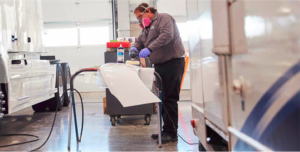When a truck or commercial vehicle is manufactured, preventative measures are taken to resist corrosion over the life of that vehicle. These preventative measures come in the form of primers, sealers, and coatings along with various application and process methods. In the event of a collision, these protective materials can be compromised and need to be restored properly. Restoring the corrosion protection and being careful not to create new corrosion hot spots is the key to a proper repair.
When asked to identify the causes of corrosion on trucks today, the common responses are salt and corrosive chemicals, moisture or damaged coatings from stone chips. Most owner/operators and repair technicians don?t consider that collision repairs are commonly the cause of premature vehicle corrosion. Common processes such as grinding, welding and cutting in the truck collision repair process can create opportunities for corrosion. If these processes are not understood and addressed with proper repair methods and corrosion protection, it can lead to cosmetic consequences or, more importantly, compromised protection of structural parts which are critical to the safety of the truck.
What exactly is corrosion? Corrosion is an electrochemical reaction called oxidation that is formed when combining exposed metal, oxygen and an electrolyte such as an acid, salt or moisture. Galvanic corrosion is another type of corrosion that occurs when two dissimilar metals come together in contact with an electrolyte such as moisture.

When OEM coatings are damaged in an accident, it leaves bare metal exposed. Once bare metal is exposed, a corrosive hot spot can start to form on the exterior and interior panels by forming flash rusting. The corrosive hot spot can negatively affect rivet joints, weld joints, floor pan, cab corner extensions and reinforcement pillars. One such coating that could be compromised during the accident is the electrodeposition coating or known as ?E-Coat?. During the repair process it is very important to maintain or keep the E-Coat intact and to only remove this coating in the necessary locations.
Areas known as the seam sealer joints can be stressed in an accident resulting in distortion, twisting and damage. Seam sealers are designed to eliminate moisture, air intrusion and, in some situations, noise. Seam sealer joints should be thoroughly inspected after an accident to determine if the seam sealer has been damaged or compromised in any way.
Improper collision repairs can affect exterior and interior truck components. Heat is a promoter of corrosion and can be neglected during the repair process. Repair technicians need to keep in mind that they create heat through grinding, cutting and welding. Continuation of applied heat to surfaces can accelerate metals to high temperatures. When the metal cools, this can result in condensation or moisture. Even though the technician works on the outside of the panel during the repair process, the backside of the panel can be affected throughout the repair. The coating on the backside of the panel is usually compromised or even removed through hammering, pulling, dollies, stud weld pin inserts and even prying. This can leave the exposed metal susceptible to corrosion.
To restore the integrity of this coating when access to the backside is difficult or limited, use 3M? 08852 Cavity Wax Plus. This product will effectively coat and protect these areas from corrosion by sealing out oxygen from the metal. This is an easy-to-use aerosolized product that can be used with a variety of application wands. The 3M? Cavity Wax Plus Applicator Wand Kit 08851 contains and 8? wand for easy-to-access areas as well as two longer wands for accessing enclosed areas (frame rails, cab corners/supports).
Technicians need to keep in mind while working with bare metal that bare hands can leave behind salt, moisture and other contaminants. This neglected habit can also lead to corrosion. Wearing gloves and designating tools for specific metals can also help to reduce the potential for creating corrosion during the repair process.
Removing rivets during a heavy duty truck repair can also contribute to galvanic corrosion. For example, steel particles being removed from the substrate can get lodged into surrounding crevice areas. Also, high amounts of heat can be generated while grinding on these substrates which can lead to a potential corrosion hot spot. 3M? Cubitron? II sanding and grinding abrasives run cool during the rivet removal process due to consistent shape mineral and fast cutting action. This can help reduce the negative effect of heat during these applications.
The other area of concern during the riveting process is the reattachment point of the rivet. During the repair process the technician inserts coated steel rivets into an aluminum substrate. Even though a coating has been applied to the surface of the rivet, the coating could be scratched during the insert process leading to galvanic corrosion. This is why it?s important during the refinish process to completely coat the rivet on the backside of the panel or even apply 3M 08852 Cavity Wax Plus as added protection.
You can see how a neglected repair processes could potentially lead to corrosion. Neglecting corrosion protection can affect the life of the truck or possibly change the designed path of energy in the event of a future accident. 3M?s commitment to the commercial vehicle and heavy duty truck market help deliver solutions for corrosion protection as well as other challenges within the repair process.
For more information on heavy duty truck repair solutions from 3M Automotive Aftermarket Division, visit 3MCollision.com/HDtrucks.
